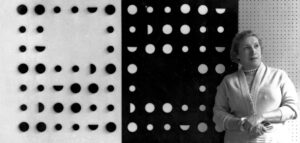Loló Soldevilla

Lolo Soldevilla (Dolores Soldevilla Nieto). Cuban painter, sculptor, draftsman and printmaker. One of the most important representatives of the geometric abstract movement and kineticism. She stood out for her praiseworthy actions as a promoter of Cuban art, both inside and outside the country. Soldevilla’s poetry, which was always based on her experimentation, made important contributions to Cuban art. Loló Soldevilla began painting in 1948 motivated, according to family references, by the close friendship she had with Wifredo Lam. A year later she settled in the French capital, where she studied sculpture at the Grande Chaumière academy, making frequent trips to Cuba to expose her multiple experiences.
She returned to France and in mid-1951 she entered the workshop of the abstract painters Dewasne and Pillet, with whom she worked for two years. At the same time, she attended a course by Professors Hayter and Cochet on engraving techniques. The exchanges she had with representatives of the School of Paris defined, to a large extent, the meaning of her work, to the point of causing a significant change in her creative process. She joined the so-called Parisian Avant-garde and participated in its exhibitions.
She was a professor at the School of Architecture at the capital’s university, and belonged to the editorial staff of the Granma Newspaper. From her aesthetic approaches emerges the plastic group Espacio. Much talked about was her exhibition Op art, Pop art, the moon and I, at the Habana Gallery. The author of the ballet in two acts Filo ten thousand, she also practiced literature in the chronicles Go, come, go again and the novel El Farol, among other works. After the revolutionary triumph she carried out other tasks, such as professor of plastic arts at the School of Architecture (1960-1961), toy designer at the National Institute of the Tourism Industry (INIT, 1962) and editor of the newspaper Granma (1965). -1971).
In 1965 she founded the plastic group Espacio and, in 1966, the Habana Gallery presented her exhibition Op art, pop art, the moon and me. She ventured into literature and also practiced, with notable successes, art criticism. Among her titles are Go, come, go again (chronicles), El farol and Bombardeo. After an intense life in the cultivation of the arts, Loló Soldevilla from Pinar del Río died in 1971. Her lush imagination recreated subjugating shapes, colors, light, gave a very special optic to her painting registered in the best of the Vanguard.
After her death, a large retrospective of her work was organized in the gallery of the Ministry of Public Health building. In 2006, the National Museum of Fine Arts (Cuba) in Havana exhibited an anthological exhibition of her work with the title Loló: an imaginary world. His works have been included in two important international exhibition projects organized in this century: Art of Cuba, a traveling exhibition through several Brazilian cities (2006), and Cuba: Art and History. From 1968 to the present, at the Museum of Fine Arts in Montreal, Canada (2008) and at the Groninger Museum, Holland (from May to September 2009).
Personal Exhibitions
At the beginning of 1957 and with the sponsorship of the National Institute of Culture (INC), he presented his personal exhibition Loló at the Palace of Fine Arts. Oil paintings, collages, luminous reliefs 1953-1956. That year she traveled to Venezuela, invited by Integral magazine, and she held a successful exhibition in the Sala del Centro Profesional del Este, in Villa Flor, Caracas. Her connection with that country went back to the relationships she had in Paris with some of the members of the group Los disidentes, made up of Venezuelans living there. Upon her return, in the month of October, she founded, together with Pedro de Oraá, the Color-Luz Gallery and, at the end of the 1950s, she joined the group Diez Pintores Concretos. After her presentation in several group exhibitions sponsored by the University City of Paris, she returned to Cuba in 1950 and exhibited her first personal exhibition in the halls of the Lyceum of Havana: Loló. Sculptures. Later, she did it at the Law School of the University of Havana under the title 20 oils of Loló.
In 1953, the Arnaud Gallery hosted the joint exhibition Loló/Varela, which was well received by specialized critics. In 1955 she exhibited luminous reliefs in the Realités Nouvelles gallery, in clear harmony with her constant eagerness for experimentation. The execution of these plastic objects, to which she incorporated artificial light, was largely the fruit of the professional relationships that she had established with the Spanish kinetic artist Eusebio Sempere, with whom she exhibited in 1954 at the Círculo de la Universidad de Valencia Spain. Around 1956 and after frequent trips to the island, she returned permanently to Cuba. That year she organized, based on the numerous originals and reproductions that she brought with her, the important exhibition Painting of Today. Avant-garde of the School of Paris, which was exhibited at the Palace of Fine Arts in Havana.